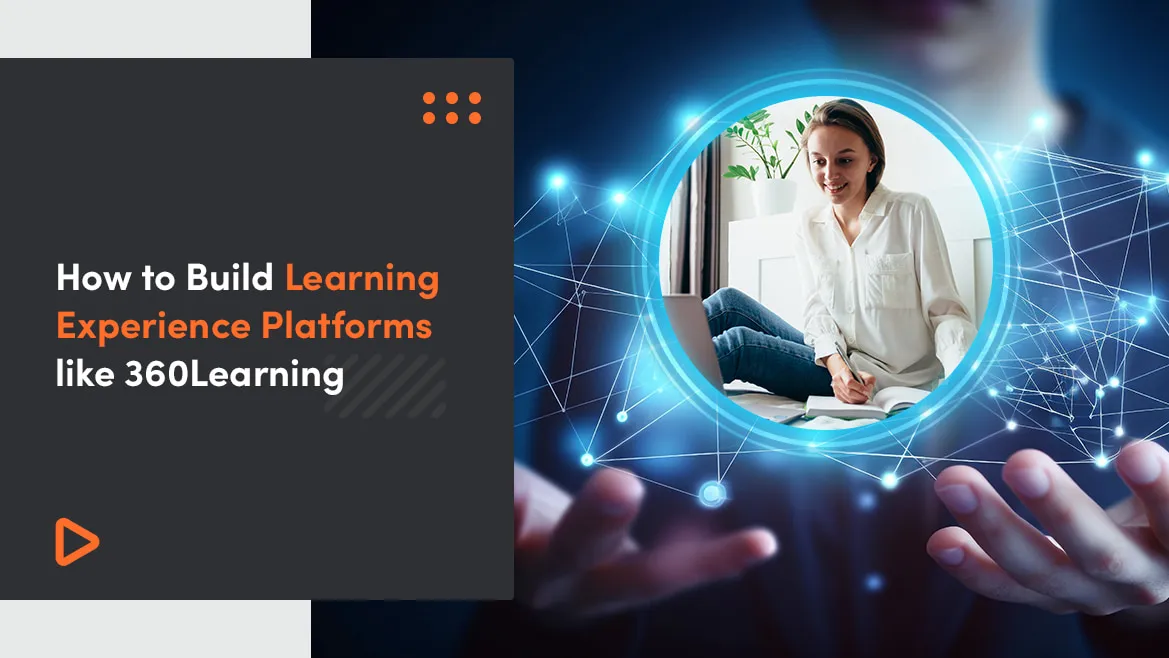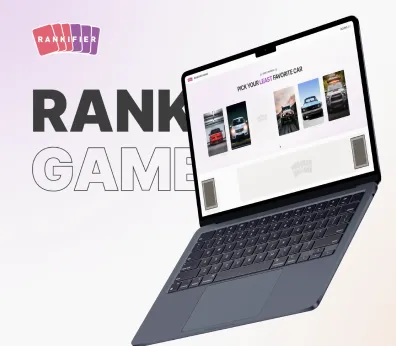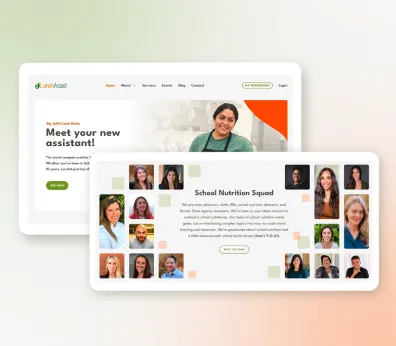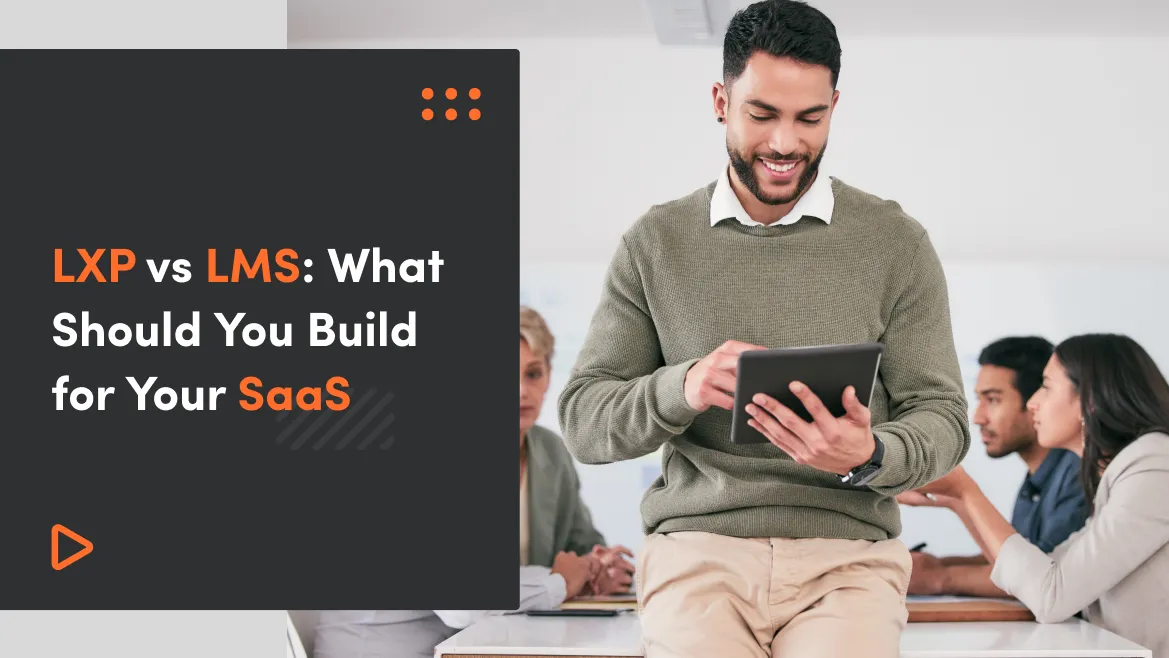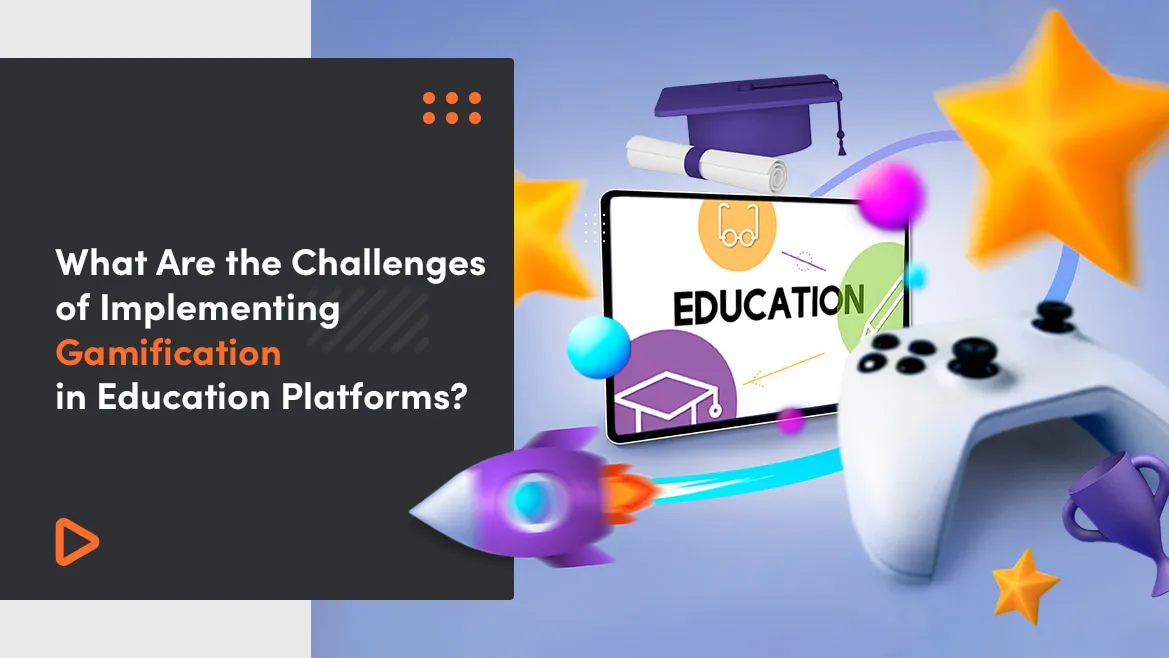Traditional learning management systems are no longer sufficient for the needs of modern businesses and their employees.
Skill development has to be dynamic and flexible, not rigid and universally standardized.
How can a business satisfy employee learning needs?
This is where the LXP market comes into play, offering platforms like 360Learning, that can change the way employees learn and grow professionally.
Moreover, the LXP market is vast and is expected to reach USD 9 billion by 2032, so it is clear it is growing in popularity very quickly.
What will you learn from this article?
- LMS is a centralized repository for learning materials, managing online training and courses, with a focus on administrative tasks.
- LXP provides personalized, engaging educational content, and allows employees to choose the learning paths and material they want with a focus on their experiences.
- LXP offers high personalization, microlearning, insights, and analytics as well as simple content curation.
- Modern learners need flexibility and control of their interactive learning environment.
- Choosing an LXP requires considering overall costs, level of control, company size, and future scalability options.
- To build a good learning experience platform you need to have edu personas in mind.
Key Takeaways
LMS is a centralized repository for learning materials, managing online training and courses, with a focus on administrative tasks.
LXP provides personalized, engaging educational content, and allows employees to choose the learning paths and material they want with a focus on their experiences.
LXP offers high personalization, microlearning, insights, and analytics as well as simple content curation.
Modern learners need flexibility and control of their interactive learning environment.
Choosing an LXP requires considering overall costs, level of control, company size, and future scalability options.
To build a good learning experience platform you need to have edu personas in mind.
What Are the Differences Between an LMS and an LXP?
Within the range of tools available to organizations to educate their employees and give them the skills they need to climb the career ladder, Learning Management Systems (LMS) and Learning Experience Platforms (LXP) are commonly used.
These two systems serve different purposes and are not strictly replacements for each other.
A Learning Management System is software that enhances an organization's learning processes by simplifying and streamlining the creation, planning, management, and tracking of educational content. It is a centralized repository for all of the organization's learning materials, and it can be an in-house solution or an outside platform. It is a very useful tool for managing online training and courses that are made available to employees, usually focused on learning in the traditional sense.
LXPs are not a management tool, but rather a platform meant for learning. They offer highly personalized and engaging educational content, often using outside resources to enhance the learning processes. Using an LXP allows employees to choose their personalized learning paths and take control of their own development, following the path they feel is most suitable for their learning style.
You will find more information here: LXP vs LMS
Learning Experience Platforms have built-in content creation tools and virtual classroom capabilities. It also allows for more interactive and collaborative learning experiences, allowing social tracking and sharing of knowledge for peer-to-peer learning purposes. More engaging learning experiences are being made with the use of highly personalized content and curated learning resources.
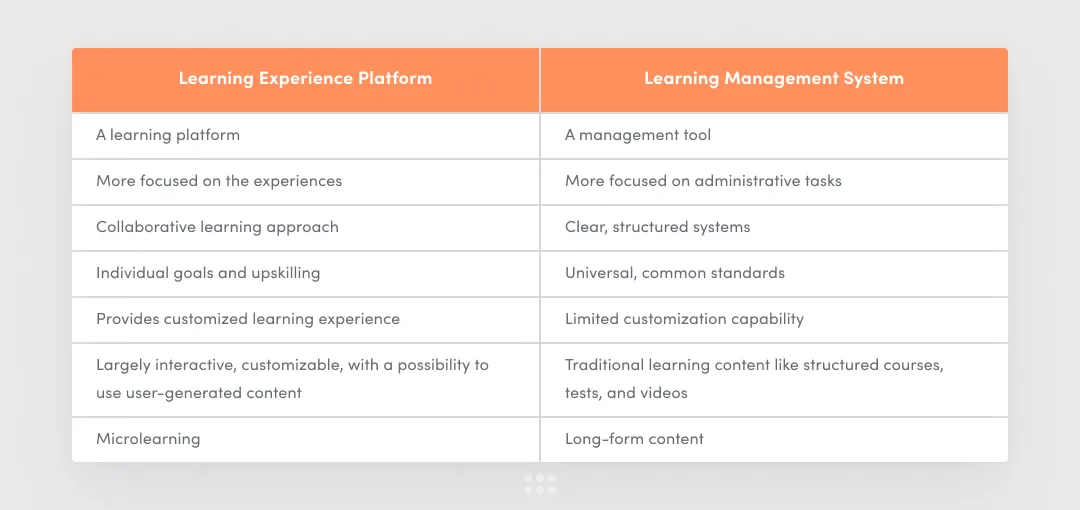
Benefits of Learning Experience Platforms
Many people believe that the main benefit is to provide personalized learning experiences tailored to individual users, but it is far from the only option. While Learning Management Systems can solve many administrative needs, LXPs offer a wide range of unique opportunities for improving the overall learning experience. Let's look at some of the main advantages that Learning Experience Platforms offer.
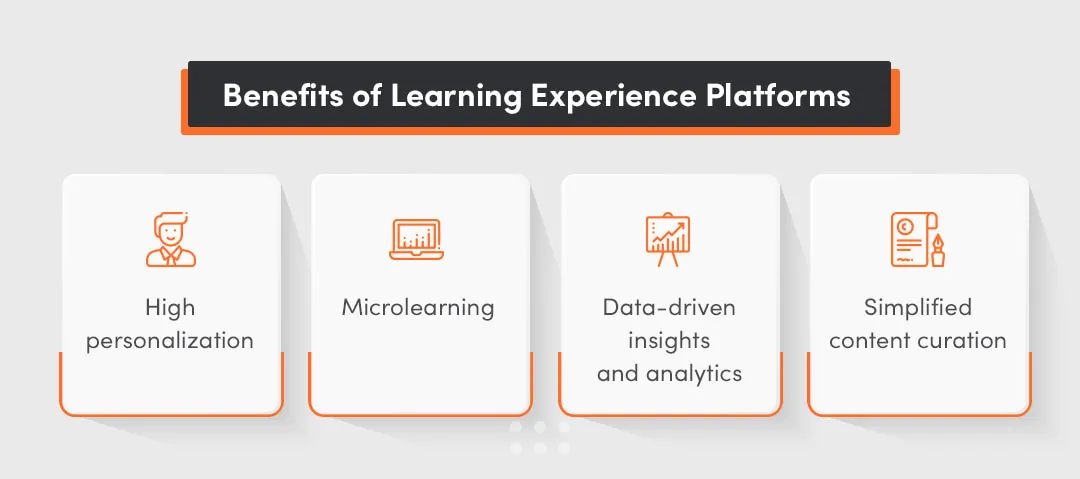
Try our developers.
Free for 2 weeks.
No risk. Just results. Get a feel for our process, speed, and quality — work with our developers for a trial sprint and see why global companies choose Selleo.
High Personalization
People expect to see relevant content tailored specifically to their needs and personal preferences. It would not be possible without highly personalized learning experiences that a Learning Experience Platform can provide.
By leveraging advanced machine learning, such platforms can offer individual learning paths, targeted recommendations, and interactive, adaptive content that caters to each user's learning style.
Microlearning
When there is a lot of material to go through at once, training and online courses can get overwhelming, causing the learner to lose motivation and feel discouraged. To avoid such an outcome, LXPs incorporate microlearning modules.
The knowledge is broken down into small, easier-to-understand, and process chunks, allowing learners to absorb information at a pace more suited to their individual learning speed.
The ability to quickly access bite-sized content also enables people to learn when they only have a short time period available for the task, making learning more convenient and flexible.
Data-driven Insights and Analytics
Thanks to the use of artificial intelligence, LXPs can give the organization a better look at each learner's progress and performance. Detailed insights can help organizations make better, data-driven decisions in relation to their learning and development strategies, making it easier to identify areas for improvement and plan further training initiatives.
Additionally, specific statistics such as time spent on different modules, completion rates, and test scores are a great way to measure the effectiveness of the learning content provided to employees.
Simplified Content Curation
Learning experience platforms need to have a large enough database of content for the learners to use to be effective. This means that LXPs should prioritize collecting high-quality, relevant content from different sources instead of relying on one single type of learning material.
However, this also means that the large amount of data to access and choose from may overwhelm users.
Fortunately, with Learning Experience Platforms, the possibility to customize and personalize the content for each learner exists. Curators can select materials and create recommendations and custom learning paths for different individuals, and it can all be done efficiently within the platform.
Curating the materials to always be fresh, diverse, and engaging will lead to a more effective learning experience for learners and a less chaotic course content system for administrators. The more sophisticated content discovery capabilities can drastically change the way users interact with the platform, making it easier for them to find the information they need quickly.
What Makes 360Learning Special?
This platform focuses on engaging learners through its wide array of social and interactive features. It was created specifically with corporate learning in mind, so it is perfectly suited for use within businesses and organizations looking to enhance their employees' skills and knowledge.
360Learning boasts an extraordinarily high course completion rate of 90%, which, compared to the usual completion rates of around 20–30% in traditional learning environments, makes the platform stand out.
Its focus on collaborative learning instead of a top-down approach is what makes it unique and more effective than the others.
Collaborative learning platforms such as 360Learning encourage knowledge sharing and peer-to-peer interactions, creating a dynamic learning experience.
Key Features of 360Learning
360Learning offers a comprehensive range of tools and functions to make learning as engaging as possible. Some features are related to content creation, others to administrative tasks, and some focus on the learning process. To showcase the app's capabilities, we have outlined the most significant aspects of this Learning Experience Platform.
Content Creation and Management
- Course builder tool
- Role-based templates
- Test-designing tools
- Content libraries
- Video coaching features
- Industry compliance and certification integration
- Content manager portal
- Content creation dashboard
Course Delivery
- Customizable learning paths
- 24/7 content availability
- Notification functionality
- Assignment scheduling
- Gamification tools
- Social learning capabilities
- Live event hosting
- Online and offline mobile support
Assignment Grading Functions
- Gradebook audit trail
- Gradebook commenting
- Manual test marking
- Various grading systems
Reporting
- Automated reports
- Visual analytics dashboard
- Artificial intelligence-based analytics tools
- Report exports in different formats
- Canned reports
These are by no means the only capabilities that 360Learning provides, as the platform includes a remarkable range of tools and functions designed to simplify and streamline learning processes. Which ones will be used and how they will be implemented will depend on the specific organization and learner group.
Hire team to Your Custom Software
Modern Learners' Needs and 360Learning

Today, people are no longer satisfied with the traditional methods. The modern learner is an independent one who needs the flexibility to learn at their own pace and on their own terms. Fortunately, 360Learning can fulfill these needs by providing the best collaborative learning experience through its many interactive features and user-friendly interface.
It can collect users' requests for more learning materials, and admins are able to easily track and respond to those requests. Learners can also collaborate with each other, sharing their knowledge and insights, in turn creating a dynamic learning environment that they prefer.
360Learning does not adhere to the old top-down approach to learning but instead allows individuals to take control of their own learning journey without the unnecessary constraints of traditional training modules.
As convenience is at the forefront of today's busy learners' minds, 360Learning offers an automated, intuitive platform that can be accessed anytime without the need for a teacher or scheduled course time.
Downsides of Learning360
As with everything, there are some downsides to using 360Learning. One of them is the lack of face-to-face interaction with other learners and instructors, which can cause difficulty in building team relationships. It may also make keeping motivation levels high more challenging, as the feeling of isolation and self-reliance can be overwhelming for some individuals.
While the self-directed nature of Learning360 can be attractive to those who enjoy flexibility and autonomy in their learning, it may be unsuitable for those who need a sense of structure and guidance. Some learners need to have a strict, organized schedule to thrive, but with platforms like Learning360 it is a bit more difficult to achieve.
Custom vs Off-the-shelf LXP Solution: What to Choose for Your Business?
Whenever choosing software for their organizations, business owners are faced with the question of whether to buy a license for an off-the-shelf solution or invest in a custom one.
While both of these options are equally good, there are several factors you need to consider before making a decision. A ready-made solution can be bought quickly and usually comes with a lower initial cost, but it may not meet all your requirements. On the other hand, while a custom one will require more time and resources to develop at first, it can be made to include specific features and functionalities that your business needs.
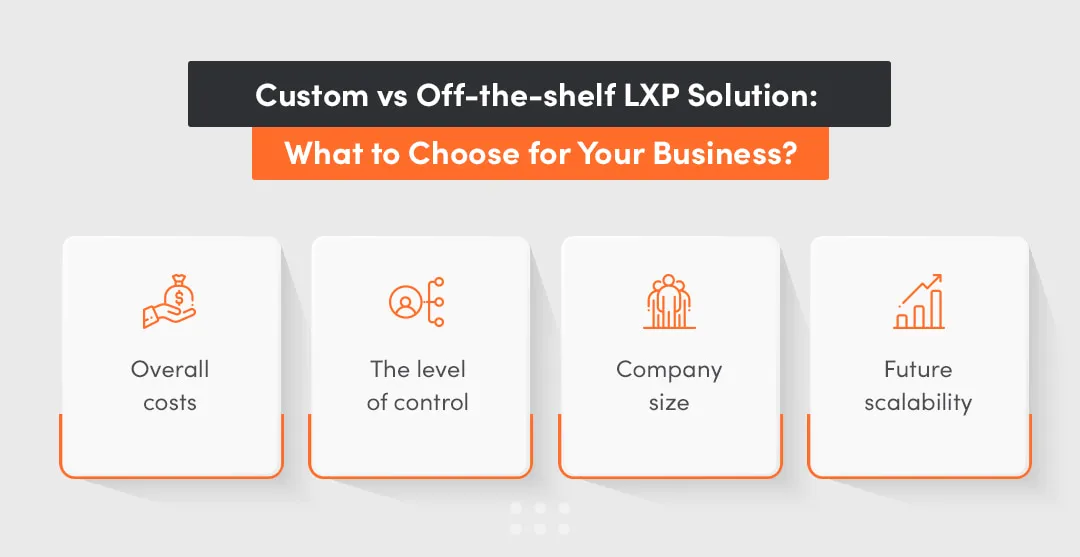
Overall Costs
If you are on a tight budget and cannot afford to wait for a platform to be made just for your business, an off-the-shelf one should serve its basic purposes without issue. If you are willing to spend a bit more and get maximum customization and functionality, then the custom solution will be the better choice.
Additionally, assess your needs and calculate how often the software will actually be used; there is no point in investing in an elaborate custom solution if you do not make full use of its features.
The Level of Control
You need to know what level of control over the platform you require and check whether the off-the-shelf solution offers such possibilities.
Most of them have limitations in terms of how much you can adjust and control, but with custom software, you can request the developers to allow you to have more administrative and operational control.
Company Size
Larger businesses may find it easier to manage their educational resources on a learning platform designed specifically for their needs. Smaller companies, on the other hand, may benefit more from a simple, ready-made solution.
However, as your business grows in the future, you also need to consider whether the software can scale with your growth.
Future Scalability
Additionally, ask yourself two questions that will help you make the choice:
- Will it be adaptable enough to accommodate your future business growth?
- Will it integrate with other learning-related systems you might want to use later?
How to Build a Learning Experience Platform: Necessary Functionalities
If you already have an LMS and would like to move it towards an LXP or are thinking about building a brand new Learning Experience Platform, here are the key functionalities to keep in mind:
User Engagement: Gamified Progress Tracking
Keeping the learners motivated and engaged is one of the primary keys to the success of the learning platform, so think about how you can increase the interest the learners have in the content.
One solid way to do so is to implement gamification-based progress tracking.
Gamification, in general, has proven very effective in increasing user engagement. Integrating elements like badges, point systems, and leaderboards can motivate learners to beat the other high scores or earn more rewards. Additionally, through interactive, gamified exercises, users can remember the material better, as the stimuli of competition and achievement can enhance their overall learning experience.
Microlearning for Easier Remembering
Long walls of text and information-dense videos are a thing of the past. Today's modern learners will benefit more from bite-sized, easily digestible content that is within their reach at any time.
Microlearning breaks down large sets of information into smaller, more manageable chunks. This way, even if the learner has only ten or fifteen minutes, they can still engage with the material.
Microlearning also helps people remember things better by using spaced repetition techniques, strengthening memory retention, and increasing engagement. Quick, easy-to-remember snippets of information are more accessible to users and have been proven to lead to better knowledge retention.
Building Edu Personas
Creating personas before developing any content is crucial. In EdTech, personas are specifically designed to represent different types of learners, allowing for content to be better tailored to their needs. Providing all individuals with the same course material on the same schedule and in the same format may not be effective.
By understanding the unique preferences of each type of learner, you can make sure that what you develop will be engaging and beneficial for a wider range of users.
To build a persona that reflects a real learner, you need to make sure that you figure out all the specific demographics, from age and education level to professional background and interests. It will work just the same as buyer personas in marketing and commerce, helping you to group the future users of your platform.
Analytics and Feedback
Thanks to machine learning algorithms and data analytics, Learning Experience Platforms can be designed to allow instructors to track the progress of individual learners, see patterns in their learning behavior, and provide personalized feedback.
It also shows what kind of content resonates with users and what is avoided or underutilized.
The data provided by the LXP analytic tools can also be valuable for platform developers, letting them know which features are most utilized and which ones need some work to improve user engagement. Artificial intelligence plays a key role in analyzing this data and providing insights that can help build even better experiences.
Summary
Learning Management Systems, as well as Learning Experience Platforms, are essential tools for organizations looking to educate their employees.
Building an LXP is a complex process that requires considering user needs, as its functionality and easiness of use directly impact the learning process. Apart from that other things should be considered like the user personas, microlearning possibilities, and flexibility.
Platforms such as 360Learning offer a great variety of functions, thanks to which course managers can create different types of content, such as interactive videos, quizzes, and assessments, that will be used by employees to enhance their skills and knowledge.
Learning Experience Platforms provide an excellent opportunity for companies to engage their employees in the learning process in a more personal and effective way. The use of a diverse range of content formats results in courses that are more interactive and engaging, which in turn increases learners' motivation and retention.
There is much to say about learning-related systems, and we will continue digging deeper into the topic, exploring things like gamification and flow theory, as well as investing in the capabilities of learning analytics further. Check out our website soon for more expert insights.
